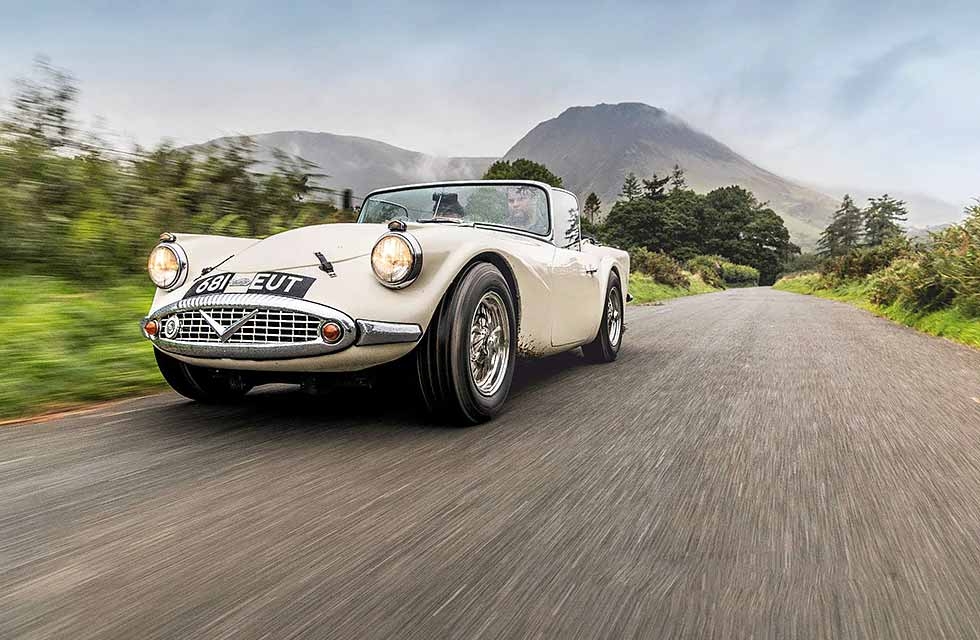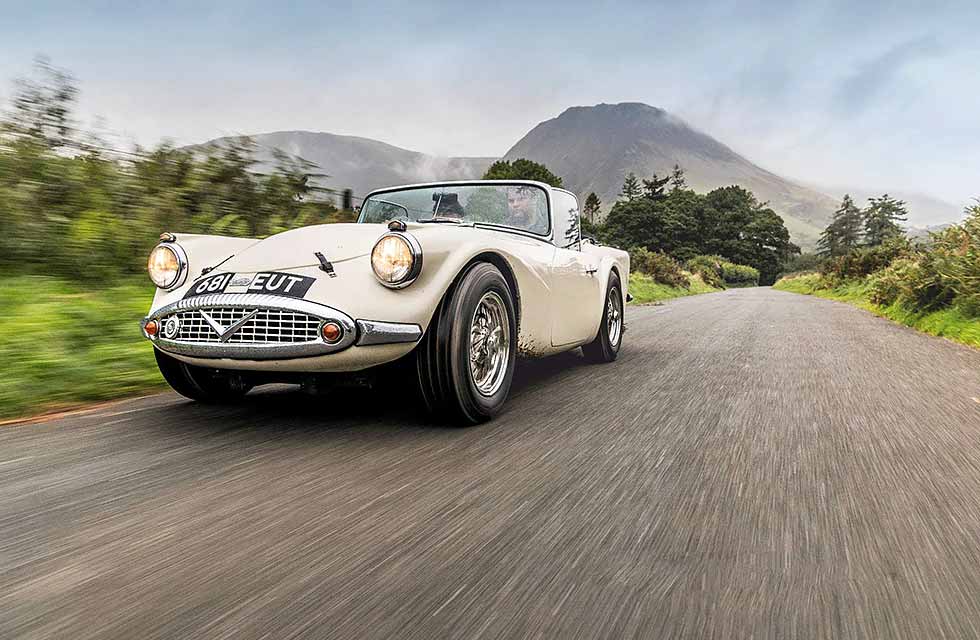
‘The prototype SP250 was utterly lethal’ John Box served as a test driver on a series of epic cross-country blasts to shake down Daimler’s SP250. Now, 60 years on, we join him as he retraces his Mid-Wales test-route. Words Sam Dawson. Photography Jonathan Jacob.
Daimler SP250
Celebrating 60 years of Daimler‘s unusual sports car, we reunite original development driver John Box with an SP250 on his 1958 Welsh test route. Daimler SP250 put to the test in Wales – by the man who developed it there in 1958. John didn’t choose Mid Wales for the scenery – or resemblence to Mordor – but for topography that pushed the SP250 to its limit and beyond.
We set of from Coventry and just kept running,’ John Box reminisces as he stands in the centre of the ancient market town of Welshpool, on the river Severn close to the English border. ‘It doesn’t look all that different today, but then again we were just passing through.’

In May 1958, citizens of Welshpool may well have been woken up at an early hour of the morning by a loud, exotic-sounding V8. Lifting the net curtains of one of these Victorian terrace bedroom windows, if they were quick enough, might have revealed a strange-looking black coupé, seemingly a mutant hybrid of Triumph TR3 and Chevrolet Corvette, thundering up the high street. Behind the wheel, a pair of apprentices in their early twenties, apparently in the middle of a great adventure.
‘I did my apprenticeship at Daimler straight from school, starting at the age of 16,’ John recalls. ‘I extended it, to five years in total, before I had to leave to do my National Service, after which I joined Standard-Triumph. The SP250 test-drive was the last thing I did at Daimler.’ John’s time at Daimler also forms a fascinating glimpse into the company’s final few years as an independent company – by the time he returned from his government-enforced stint in the Army, John’s former employers had become a division of Jaguar.
‘Norman Dewis had a different approach – he was in charge of testing and pretty much did it all himself. Whereas at Daimler, I worked in the Experimental Department. I was one of a team of three engineers – me, Sid Hartsilver and Roger Garrett – who’d test new ideas, then take an experimental car on a long test-drive, out to Wales or Devon, bring it back to the factory for 5pm, wash it, check the oil, and leave a note of things for the next experimental team to adjust.’
As John brings this lost world of prototype road-testing to life, we hear a distinctive rumble a few streets away. It doesn’t have the deep bass thump of a massive American V8, nor is it smothered into a smoothly inoffensive drone like a plodding British luxury straight-six of the Fifties. ‘That noise always reminded me of an expensive Italian motorboat,’ beams John as the ivory-white shape of Matthew Waterhouse’s Daimler SP250 jiggles into view over a speed hump. I can see what he means – it emit a rich marine burble from a time when Maserati supplied engines to water speed-record contenders. I can close my eyes and picture it emerging from some cyan-tinged, white-wash-walled Italian quayside in the Dolce Vita era.
Upon opening them again, I feel I have to bring up the question of styling. Thankfully this SP250 isn’t encumbered by the pronged optional front bumper that complicated the design further. From certain frontal angles I can almost see a foretaste of the Jaguar E-type Series III in its overwrought grille, headlight and bumperette shapes. But it gets more and more ungainly as its flanks sweep alongside us. The low of the flared wheelarches suggests sweeping bodylines that the car simply doesn’t have, and its tailins look like a faddish afterthought. But for me, the worst aspect of the design is the doors. They’re slabby, high-sided, and topped with gawky window frames that echo the tailins’ shape, conspiring to make the glasshouse of the car look more bulbous than it actually is.
John doesn’t regard the SP250’s styling with great affection, but as he explains as he settles in behind the wheel and pulls some cherished old Box Brownie photos he took of the original prototype from his pocket, there are reasons why it looks the way it does. ‘This thing was copied from the Triumph TR3A,’ says John. The prototype’s lines were later echoed in the SP250’s wheelarch embellishments, but the prototype sported TR3-style cutaway doors, sloping tail and a plainer, more restrained grille. ‘It’s basically the same chassis with a four-inch-longer wheelbase. It was all Edward Turner’s idea – he wanted to build a sports car to take on the AC Ace, the benchmark at the time, with a new compact V8 he designed drawing on his Triumph motorcycle experience, and felt that something similar to a TR3A would be ideal. If only he’d waited a couple of years until the TR4 had come out, it might have provided more up-to-date inspiration!
‘Our test car was a hardtop coupé – it looked like a bolt-on accessory, but was actually part of the glassfibre bodywork and helped keep the whole thing together. The open cars always had flexibility problems – bodywork would lap about and doors would pop open on corners. The prototype also had an Austin-Healey gearbox and Triumph front suspension. The tailins were added later by Turner, who was obsessed with Cadillacs.’
As we accelerate out of Welshpool and enter the snaking bends of the A458 towards Llanfair, John smiles as he revels in the handling of this well-sorted production SP250. ‘That prototype was utterly lethal – we’d drive tail-out round that hairpin! The Triumph suspension couldn’t cope with the V8’s power, and the car had been fitted with Dunlops that were highly speed-rated in theory, but seemed to offer no front-end grip at all. Sid and I ended up having to contend with desperate understeer and it would regularly skid straight of the road.
‘During the test drive, we actually knocked down someone’s garden wall. It was three in the morning and we rounded a tight Z-bend on a country lane near Wells, Somerset. Thankfully, the car rode up into the bottom of the wall, and it fell away from us rather than on to the bonnet. Sid was propelled forward, curled up in the passenger-side footwell. We checked the car, realised the crash had only damaged the grille, figured no-one had noticed and drove of into the night. Bit naughty of us, I know!’
But the car had its revenge. ‘That black prototype was written of during high-speed testing at MIRA,’ says John. ‘It lost grip at the top of the banking, knocked the safety pillars down and lipped over. The driver was ok. Amazingly, the shop steward present at the MIRA test didn’t want criticism of the car getting back to the Daimler board, because he didn’t want to jeopardise the workers’ overtime arrangements. The rest of the testing was done in an open car with coachwork by Carbodies, wearing such exaggerated ins it looked like it had bent in the middle – they were actually toned down for production.
‘I was used to driving in variable conditions. I was brought up out in the sticks, in Westmorland, Cumbria. When I began my apprenticeship I hadn’t actually passed my driving test yet, but once I had the Daimler management was very free and easy with who it’d let drive. Before long, at the age of 18 I was driving Conquest roadsters to the docks for export, or wafting down to London in a nice Century. Those were always quite cramped in the front though. Partly because they were chauffeur-driven cars and the emphasis was on rear-seat comfort, but also because the Daimler board, who signed of the final designs, were all shorter than average, so there was no-one to point out the problem!’
As we bypass Llanfair and start to climb into the mountains towards Lake Bala, John switches into road-testing mode again. ‘It really does make a lovely old growl, and the chassis is quite composed on a smooth road, but you can still feel that bodywork lapping around,’ he notes. ‘It was a difficult car for us to assess really. I’d been brought up with the idea of Daimlers being well-built luxury cars. But the SP250 was more like a fantastic engine looking for a car to put it in. It took Bill Lyons to find it in the end – the 250 saloon was perfect, better than the Jaguar Mk2!
‘Our sense at the time was that the SP250 wasn’t a real Daimler, but a new kind of Triumph sports car. That was down to Turner. In the Fifties Daimler’s management was all elderly, out of date. Turner was brought in and put in charge of engineering, to modernise the cars, but he was a fairly bombastic character with a reputation for poor man-management, giving people a dressing-down in front of their colleagues, for example. But he was respected as a great engineer. He had his V8 with its motorcycle-inspired combustion chamber design, and part of the deal with hiring him from Triumph was that he could design a sports car to put it in, because he thought he’d sell several thousand in the US via Triumph motorcycle dealers. That’s why several parts on the SP250 are actually from bikes rather than cars – the indicator lights, for example.
‘Of course, when it was launched at the New York Motor Show it was voted the ugliest car there,’ John chuckles. The price didn’t help either. Daimler created an extensive options list to keep the basic price down, but its hand-built nature plus export tariffs put its price a few hundred dollars above that of the Chevrolet Corvette, which didn’t handle as well, but offered the same concoction of glassfibre body and V8 engine, yet in a beautiful package. ‘We sold quite a few in Australia and New Zealand though,’ John points out. ‘However, it does amuse me that, as a classic, it’s become the most popular Daimler – most of the 2500 or so examples made are still around. The glassfibre body helps its survival, I suppose, and it’s an easy car to look after.’
We pull to a halt next to the turn-of for the village of Dinas Mawddwy. John doesn’t need a map. The road-test route is imprinted on his mind.
‘I wonder if there’s still anyone around in this village from the Fifties, who has memories of road-testers?’ He muses. ‘Because it wasn’t just Daimler, all the West Midlands motor industry used mid-Wales as a test track. Certain hill climb routes like this one, up above Lake Bala, were ideal for testing brakes, and making sure cars didn’t overheat.
‘In fact, during that test drive in 1958, we encountered a team from BMC testing a prototype small car on this same route, an unusual thing we kept catching sight of, but every time it stopped a group of tall men would get out of a van and stand around the car so no-one could get a photo of it. Of course a year later we realised we were among the first people to see a Mini. We didn’t quite have the same problem – no-one would have guessed this sports car was going to be a Daimler – but just to be certain, there were no badges on it and even the tax disc in the windscreen had black tape over it. We were under instructions only to remove it if the police asked us to.’
The SP250 grumbles its way out of Dinas Mawddwy and up the narrow, winding road clinging to the Eastern slopes of Aran Fawddwy, a verdant world of mist, Lake Vyrnwy glinting distantly in the valley behind us. John works the gears, keeping the slick gearbox – Daimler’s own, but copied from Triumph’s TR3A design at great expense – in its lower ratios as we climb. ‘Daimlers had traditionally had automatics – they’d never built an all-synchromesh manual before.’
‘The prototype had the Austin-Healey gearbox, a strange contraption, with the first and second ratios very close together, then a giant leap to third,’ says John. ‘But I remember leaving a note about the positioning of the lever itself, which they never rectified. Either the lever should have been three inches further back from the dashboard, or cranked to clear it. First and third are too far forward.
‘We used this hill for the temperature test, to make sure the engine wouldn’t overheat under heavy load. It didn’t, but it did get very hot, and the brakes – Dunlop again, they eventually used Girlings – weren’t very effective. The weather was just like it is today actually – sunny and warm in the valleys, cool and occasionally drizzly in the mountains – and there were no problems with the engine at all throughout the test. It even survived a radiator leak – easily fixed – brought about by that excursion into the garden wall in Wells.’
We pull into a mountaintop car park overlooking Lake Bala, and allow the Daimler to tick cool. As a charmingly lawed classic, John loves the SP250 – he even owned one himself back in the 2000s – but as a new car, it was a very different prospect.
‘When the Daimler hierarchy asked me what I thought of the car, I knew I was leaving to do my National Service so I said, “it’s going to kill all your customers, you’d better do something about it!” It understeered to the point where the steering didn’t appear to work at all, the brakes were ineffective and the throttle was savage.’ Thankfully, John’s advice was heeded.
‘Daimler might not have sold as many as they’d like, but it was such a good car that the police used them for motorway patrols, which says a lot,’ John notes. ‘But I still think we could’ve done more with that engine. We put one in a Century and used to chase Jaguars round the A45 with it. It was a great Q-car and I think we could have sold quite a few. It didn’t need any modifications to it either, bolting straight onto the Borg Warner 35 automatic transmission. Obviously Jaguar did something similar with the V8 250.’
But there’s something else about this car’s character. No, it’s not pretty, nor did it uphold Daimler’s established standards of finesse. But its glassfibre body, squirming chassis and compact V8 are all reminding me of something else. John begins another great anecdote, and suddenly it all falls into place.
‘In later life I went to work for Peter Wheeler, who wanted to put a V8 in the TVR Tasmin and needed the chassis sorting out…’
TECHNICAL DATA FILE SPECIFICATIONS 1959 Daimler SP250
Engine 2548cc V8, ohv, two SU HD6 carburettors
Max Power 140bhp @ 5800rpm / DIN
Max Torque 155lb ft @ 3600rpm / DIN
Transmission Four-speed manual, rear-wheel drive
Steering Cam and lever Suspension Front: independent, wishbones, coil springs, telescopic dampers. Rear: live axle, semi-elliptic leaf springs, lever-arm dampers
Brakes Discs front and rear
Weight 1016kg
Performance Top speed: 126mph; 0-60mph: 8.9sec
Fuel consumption 29mpg
Cost new £1395
Classic Cars Price Guide £20,000-£47,500
‘The open cars always had flexibility problems – doors would pop open on corners’
Frank feedback from the road test team was instrumental in ridding the SP250 of its early handling foibles. John retraces an old hill climb route he and his fellow apprentices used to test the car’s brakes and cooling. The controversial tailins were added late-on by engineer Edward Turner; John remembers the prototype SP250 roadsters being less resolved than this production example.
One of the team’s duties was to test the V8’s cooling system. John with the team’s hard-worked test mule. Pretty it wasn’t, but it set a template that John Box happened upon again later in his career. The Daimler V8 had broader potential. One of John’s tasks was trying to push the engine to boiling point.
‘We actually ended up knocking down someone’s garden wall on a test drive at three in the morning’
OWNING A DAIMLER SP250
‘It’s a very DIY-friendly classic,’ says Matthew Waterhouse, whose longterm SP250 ‘comes out for long drives in all weathers’.
‘Obviously you need to keep an eye on the chassis for rust, but generally they were very tough and most of the car is very rust-resistant, which helps keep maintenance costs down. Electrics are fairly minimal so they don’t tend to suffer the usual earthing issues of younger, more complicated cars. That said, keep an eye out for leaks around the carburettors because engine fires aren’t unknown.
‘There are a few upgrades that make them easier to live with, which most will have had by now. MWS offers slightly wider chrome wire wheels. A Triumph 2000 saloon rack-and-pinion steering setup is less hard work than the original cam-and-lever and will it straight in.
I’ve fitted lower seat runners for more legroom and drop my eyeline below the windscreen header rail. Bonnet straps weren’t original but are vital – SP250 panels were never very secure. The last thing you want is the bonnet lying up and crashing down on your head. I speak from experience!’






